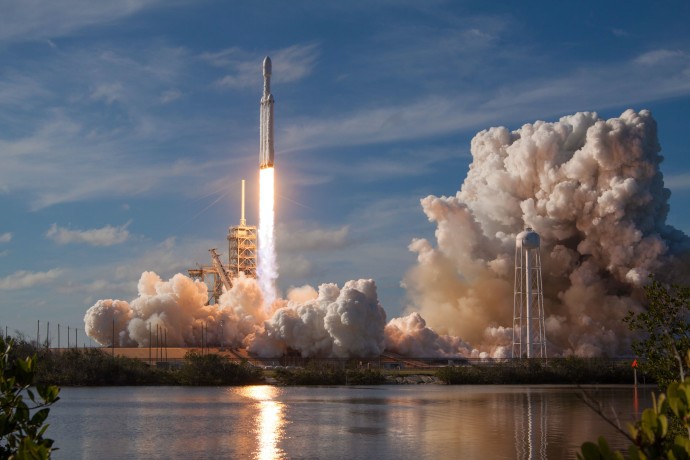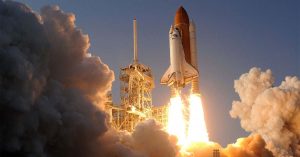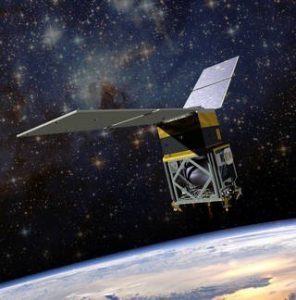
Movement requires expenditure of energy. While we walk towards a desired destination, we expend energy which powers our body to perform that particular action. Here, our body is the ‘system’ and the energy derived from various food sources is the ‘fuel’. Contextualizing this in the field of ‘rocket science’, it should be easy for us to understand the rocket fuel system. Rockets are used to take payloads into space. The payload may consist of satellites, spacecrafts, humans, animals or even a Tesla!
But, what takes the rocket itself into space?
Enter the rocket fuel, or the rocket propellant.

What is Rocket Fuel / Rocket Propellant?
The term rocket fuel and rocket propellant, is used interchangeably in layman’s terms. However, these two terms differ slightly. A normal fuel is a substance, which combines with oxygen, and then produces energy for the mechanism to run. In case of a propellant, we use a combination of the fuel and an additional oxidizer to power the system. This propellant is a chemical mixture which is combined in a ratio, called as the mixture ratio, and is taken as the ratio of the fuel to the oxidizer. Now the question comes, why are we using this term ‘propellant’? Well, to propel something means to eject something at a good velocity. In order to propel (or eject the rocket at higher velocity), the term propellant is more improved. When the propellant is ejected at an enormous velocity, a greater amount of thrust is produced, and this thrust is what which lifts up our rocket, into much higher altitudes. Since, there is no atmosphere in space, the rocket has to carry its own oxidizer along with the fuel.
What is the Rocket Propellant made of ?
Composition of Rocket Propellant
In order to understand, what a propellant is made up of, we must know about different types of propellants, as each one of them utilizes varied materials as well as substances. However, we’ll be discussing few constituents in a brief manner.
In a rocket, where a solid is used as a propellant, aluminum is used as the base fuel. The oxidizer in this case is ammonium perchlorate, which burns the aluminum. In several cases, plastics and hydrocarbons are even used as fuel, with oxidizers like ammonium nitrate or potassium chlorate etc. A binder is present which binds both the fuel and oxidizer in a solid propellant.
In case of a liquid propellant base rocket, liquid hydrogen is used as fuel while liquid oxygen is used as an oxidizer. Apart from liquid hydrogen and oxygen, fluorine is also utilized as an oxidizer whereas kerosene and hydrazine are used as fuels.
Rocket Propellant – Types and Forms
There are broadly, three types of rocket propellants based on the nature of components:
Solid Propellants, Liquid Propellants & Hybrid Propellants.
Let’s have a closer look at them one by one.
-
Solid Chemical Propellant
Solid rocket propellants are the simplest kind of rocket fuel. The propellant is placed in a casing (usually made from steel). When ignited, it burns from the center to outward. There are two families of solid propellants:
- Homogenous Propellant – Homogenous propellants may have one to three bases along with the binders. As the name suggests, there would be homogenous or zero separation boundary between the fuel or binder.
- Composite Propellant – Here, the fuel and oxidizer are present in a grain form along with the binder.
The main advantage of a solid fuel is that it is easy to store while the disadvantage is that they can’t be shut down, once it’s ignited.
-
Liquid Chemical Propellant
In liquid rocket propellant, the fuel and oxidizer are separated and kept in two different containers. They are again divided into three families:
- Petroleum Fuels – They are extracted from crude oil and contains a mixture of complex hydrocarbons. They generally have kerosene which is greatly refined.
- Cryogenic Propellant – Cryogens are liquified gases which are stored at very low temperature. Examples include, liquid methane, liquid hydrogen etc.
- Hypergolic Propellant – It constitutes of a combination of hypergolic fuel and oxidizer which when gets into contact with each other, leads to their ignition without the assistance of any other ignition source.
The advantage of liquid fuel is that by using them, the engine can be restarted whenever required whereas the disadvantage of them is that their oxidizers are extremely reactive.
-
Hybrid Propellant
In most of hybrid propellant, the solid propellant is used as the main fuel whereas a liquid as the oxidizer. Herein, the liquid is injected into the solid fuel. The main advantage of a hybrid propellant is that they have very high performance while their disadvantage is that, this concept in actual use can’t be for the large thrusters.
Rocket Fuels used by India and USA
Propellants used by the Indian space related organizations include, the UDMH fuel (Unsymmetrical Di-Methyl Hydrazine) along with the oxidizer nitrogen tetroxide. Both of them being very toxic and corrosive are thus called as a ‘dirty combination’. Other propellant used in India, comprises of ISROSENE (developed by ISRO), which is a grade version of kerosene. In the United States, a specific type of petroleum in the form of highly refined kerosene, called RP- 1 is used as rocket fuel. Other fuel used in the US, is the methane fuel, generally for Martian missions. A combination of liquid oxygen (LOX) and ethyl alcohol was used in the USA Redstone.
Cost of Rocket Propellant – The Fee Factor
The actual price of the propellant is relatively lesser when compared to the handling cost of the propellant. But then how do you determine the cost of rocket fuels and propellants? In order to govern the cost, one must know the mass of the propellant required. The amount of the propellant will thereby tell the overall charge of your fuel. Mathematically, it is known that estimating the cost of liquid propellant is much easier than finding the cost of a solid propellant. Now, in terms of money, (as per a 2001 data), a gallon of hydrogen costs 98 cents and weighs about 0.26 kg, thus the total amount paid for liquid hydrogen was $ 3.66 per kg. Similarly, a gallon of oxygen costs 67 cents and weighs about 4.32 kg, thus the total amount paid for liquid oxygen was $ 0.16 per kg (by NASA’s purchase).
Companies Producing Rocket Propellant
Companies like ‘Wax’ and ‘Merlin’ are some of the major suppliers of rocket fuels globally. In India, ‘Andhra Sugars Ltd’ has also become a supplier of cryogenic fuel to the Indian Space Research Organization. Further, Jeff Bezo’s Blue Origin is also utilizing liquid hydrogen and oxygen. In space propulsion, ‘Ad Astra Rocket’, is a respectable name. Currently, they’re reenergizing in electric propulsion systems which is proved to be more efficient than chemical propellants.
Rocket Fuels – Environmental Impact
The process of propulsion has been estimated to have a significant impact on the atmosphere of our planet and have an adverse influence on the environment. Rockets leave a huge carbon footprint while launching. This is especially so, in the case of solid rocket fuels. In case of liquid propellant, there is slightly less pollution as liquid hydrogen commonly produces clean water vapor. Exhaust or trace gases produced by rocket engines in the stratosphere can cause damage to the ozone layer. Other exhaust constituents emitted by a skyrocket include alumina, black carbon, hydrogen, hydrogen chloride, nitrogen oxides, carbon monoxide or in few cases, sulphur compounds. More information on pollution caused by rockets may be read here
Nevertheless, the promises held by the potential of space exploration and rapid advancement in cleaner fuels, along with more efficient propulsion technologies tip the scale on more prolific use of rocket fuels and propellants.
The Future of Rocket Propellants
In India, the Indian Space Research Organization (ISRO) is developing ‘green propulsion technology’. This technology practices the elimination of all toxic and hazardous substances for launching systems or propulsion; taken as a step for environment – friendly technology. Even the National Aeronautics Space Administration (NASA) along with SpaceX is focusing on the Green Propellant Infusion Mission (GPIM) which offers 50% better performance and is denser than hydrazine.
There is even a scope of using hydrogen as a fuel in broader aspects due to its simplicity and easy availability. Plus, it emits little to no contaminating particles. Besides launching from Earth, it is proposed that spacecrafts in Mars Missions can use the methane present in the supposedly methane positive atmosphere of the Red Planet for returning back to the Earth. There has been much speculation on this however, and further data may be required to substantiate the idea. Supervisions like Firefly Alpha and Blue Origin’s BE-4 engine are working to use methane-based fuel in the near future.
The journey of a rocket system to deep dive into space cannot be imagined without the centrality occupied by rocket propellants. Rocket fuels are a pivotal component of our space dreams and of crucial importance if humans are to evolve themselves into an interplanetary species.
By Ayachi Mishra
Sources and further reads:
https://history.nasa.gov/conghand/propelnt.htm
http://www.braeunig.us/space/propel.htm

